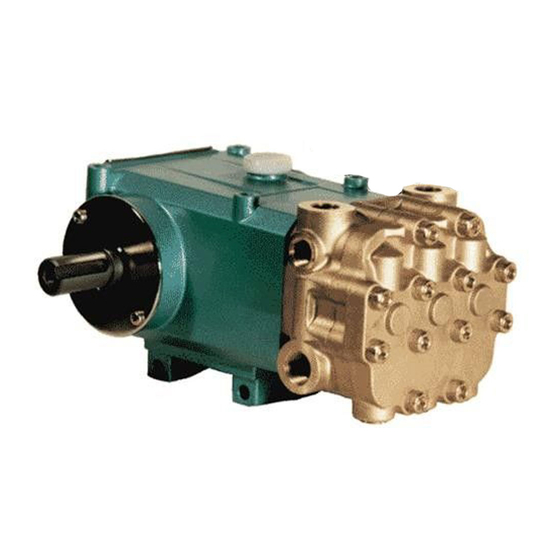ARIMITSU 511 설치 및 시작 정보 - 페이지 6
{카테고리_이름} ARIMITSU 511에 대한 설치 및 시작 정보을 온라인으로 검색하거나 PDF를 다운로드하세요. ARIMITSU 511 6 페이지.

Several elements make up a complete, functioning pumping system. All of these elements need to be operating correctly in order for the whole system to
function. Some of the elements include: duty-cycle, liquid being pumped, operating conditions and specifications versus the ratings and capabilities of the
pump and accessories. Proper care and maintenance of pump and system components will maximize the life of your equipment. Review and follow
recommendations regarding system design and inlet conditions to avoid potential problems.
Arimitsu Pumps are designed to offer superior life and be easy to service. Field servicing can be accomplished with standard tools. Use the following table as a
guide to determine cause and remedy for possible problems. Contact Arimitsu Pumps directly via web site or telephone for further assistance.
PROBLEM
Low pressure
Pulsation
Water leak
•Under the manifold
•Into the crankcase
Knocking noise
•Inlet supply
•Pulley
Oil leak
•Crankcase oil seals
•Crankshaft oil seals and o-rings
•Drain plug
•Rear cover
•Filler cap
Pump runs extremely rough
•Inlet conditions
•Pump valves
•Pump seals
Premature seal failure
DIAGNOSIS AND MAINTENANCE
PROBABLE CAUSE
• Worn nozzle.
• Belt slippage.
• Air leak in inlet plumbing.
• Pressure gauge inoperative or not registering accurately.
• Relief valve stuck, partially plugged or improperly adjusted.
• Inlet suction strainer (filter) clogged or improperly sized.
• Abrasives in pumped liquid.
• Leaky discharge hose or spray gun.
• Inadequate liquid supply.
• Severe cavitation.
• Worn Seals.
• Worn or dirty inlet/discharge valves.
• Faulty Pulsation Dampener.
• Foreign material trapped in inlet/discharge valves.
• Worn V-Packings, Hi-Pressure or Lo-Pressure Seals.
• Humid air condensing into water inside the crankcase.
• Excessive wear to seals and V-Packings.
• Inadequate inlet liquid supply.
• Loose pulley on crankshaft
Recommended Oil Service Intervals: After first 30 hours, every 500 hours thereafter.
• Worn crankcase oil seals.
• Worn crankshaft oil seals or o-rings on bearing cover.
• Loose drain plug or worn drain plug o-ring.
• Loose rear cover or worn rear cover gasket.
• Excessive oil in crankcase.
• Restricted inlet or air entering the inlet plumbing.
• Stuck inlet/discharge valves.
• Leaking V-Packings, Hi-Pressure or Lo-Pressure seals.
• Scored plungers.
• Over pressure to inlet manifold.
• Abrasive material in the liquid being pumped.
• Excessive pressure and/or temperature of pumped liquid.
• Running pump dry.
• Starving pump of adequate liquid.
SOLUTION
• Replace with properly sized nozzle.
• Tighten belt(s) or install new belt(s).
• Tighten fittings and hoses. Use PTFE liquid or tape.
• Check with new gauge. Replace worn or damaged gauge.
• Clean/adjust relief valve. Replace worn seats/valves and o-rings.
• Clean filter. Use adequate size filter. Check more frequently.
• Install proper filter.
• Replace discharge hose with proper rating for system.
• Check & clean filters.
• Check inlet conditions.
• Install new seal kit. Increase frequency of service.
• Clean inlet/discharge valves or install new valve kit.
• Check precharge. If low, recharge, or install new dampener or pulse hose.
• Clean inlet/discharge valves or install new valve kit.
• Install new seal kit. Increase frequency of service.
• Change oil every 3 months or 500 hours.
• Install new seal kit. Increase frequency of service. Check inlet &
water conditions
• Check liquid supply. Increase line size, pressurize, or dual feed.
• Check key and tighten set screw.
• Replace crankcase oil seals.
• Remove bearing cover and replace o-rings and/or oil seals.
• Tighten drain plug or replace o-ring.
• Tighten rear cover or replace gasket.
• Fill crankcase to specified capacity, do not overfill.
• Correct inlet size plumbing. Check for loose connections. Clean filters.
• Clean out foreign material or install new valve kit.
• Install new seal kit. Increase frequency of service.
• Replace plungers, check inlet conditions.
• Reduce inlet pressure per specifications.
• Install proper filtration at pump inlet and clean regularly.
• Check pressure and inlet liquid temperature.
• DO NOT RUN PUMP WITHOUT LIQUID.
• Increase hose one size larger than inlet port size. Pressurize and
dual feed.
